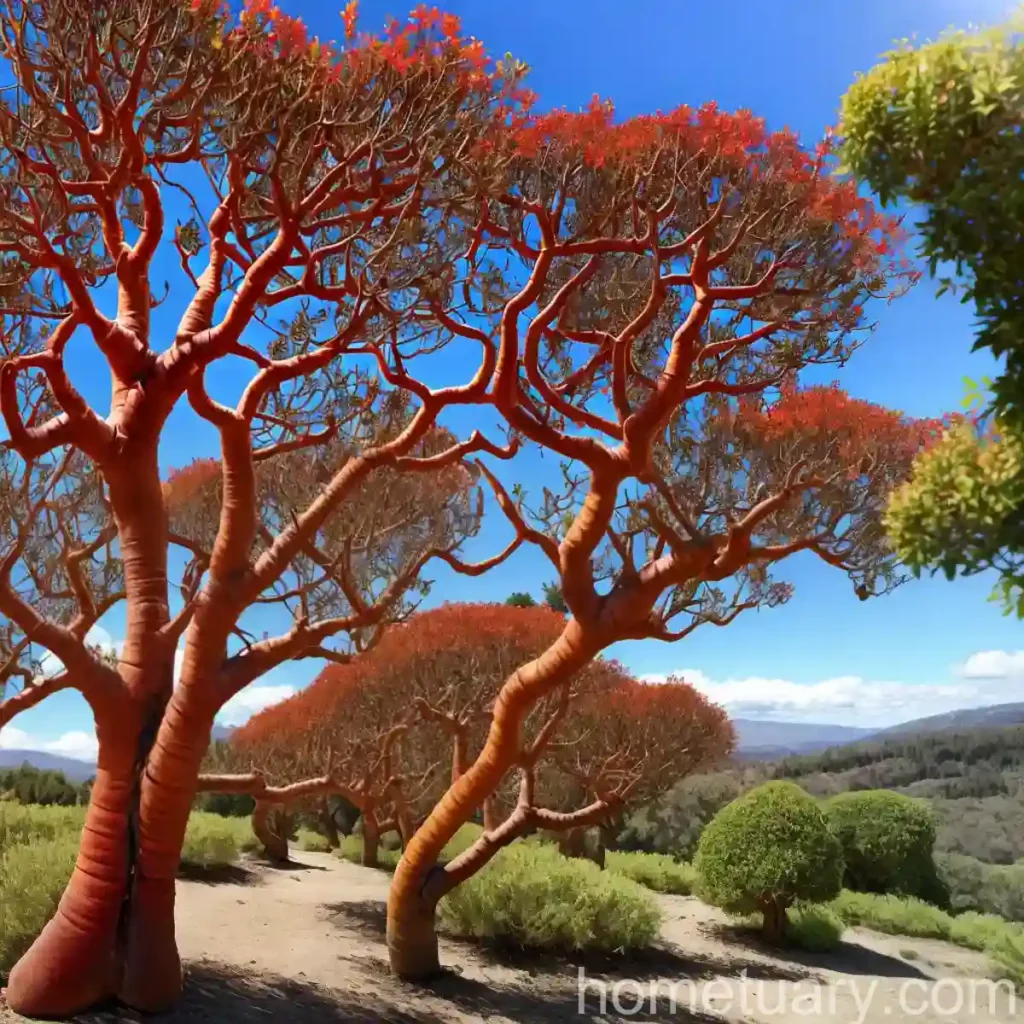Madrone (Arbutus menziesii) – The Iconic Tree of the Pacific Northwest
The Madrone (Arbutus menziesii) is a fascinating and iconic tree that is native to the Pacific Northwest region of North America. Its scientific name, Arbutus menziesii, pays tribute to Archibald Menzies, a Scottish naturalist who discovered the plant during the late 18th century. The Madrone tree, also known as the Pacific Madrone, Madrona, or California Madrone, is celebrated for its stunning appearance, unique cultural significance, and ecological importance. In this comprehensive guide, we will explore all aspects of the Madrone tree, including its cultural uses, habitat, care requirements, ecological role, and much more.
What is the Madrone (Arbutus menziesii)?
The Pacific Madrone, scientifically known as Arbutus menziesii, is an evergreen tree belonging to the family Ericaceae. It is characterized by its distinctive features, including smooth reddish-brown bark that exfoliates in summer, glossy green leaves, and clusters of small, urn-shaped white flowers. The tree is also renowned for its bright red-orange berries which provide essential food for various wildlife species. The Madrone tree typically reaches heights of 10-25 meters and can live for several centuries under favorable conditions. Its graceful, twisting branches and striking foliage make it a beloved symbol of the Pacific Northwest’s natural landscape.
Key Takeaways
Before delving into the specifics of the Madrone tree, let’s highlight some key takeaways that will guide our exploration of this unique species:
- Common Names: Pacific Madrone Tree, Arbutus Menziesii Plant, Madrona Tree, California Madrone, Pacific Arbutus Tree
- Characteristics: Distinctive smooth reddish-brown bark, glossy evergreen leaves, white urn-shaped flowers, red-orange berries
- Habitat: Native to the Pacific Northwest region of North America, particularly prevalent in coastal areas and dry forests
- Ecological Significance: Provides valuable food and habitat for wildlife, plays a crucial role in maintaining ecosystem biodiversity
- Cultural Uses: Traditionally valued for its wood, bark, medicinal properties, and symbolic significance in indigenous cultures
- Conservation Status: While not currently listed as endangered, conservation efforts are important to protect Madrone populations and their habitats
- Landscaping and Ornamental Value: A popular choice for landscaping due to its aesthetic appeal and drought tolerance
Now that we have an overview of the Madrone tree, let’s delve into the specific aspects of its culture, uses, care requirements, ecological role, and more.
Culture
Understanding the cultural significance of the Madrone tree is essential to appreciating its deep-rooted connections to indigenous traditions, ecological stewardship, and contemporary uses. Throughout history, the Madrone tree has been revered for its versatile applications, symbolic meanings, and ecological interactions, shaping diverse cultural narratives and practices.
Uses
The Madrone tree holds immense cultural and practical value, offering a range of traditional and contemporary uses that reflect its ecological bounty and symbolic resonance:
Wood and Bark
One of the most significant uses of the Madrone tree is the utilization of its wood and bark for various purposes. The wood of the Madrone is esteemed for its rich, reddish hues, fine grain, and durability, making it highly sought after for woodworking, cabinetry, and artistic crafts. The bark, with its smooth texture and distinctive patterns, has been traditionally used in basketry, cordage, and other forms of traditional crafts by indigenous communities.
Medicinal Properties
In indigenous cultures, the Madrone tree has been recognized for its medicinal properties, ranging from the treatment of ailments to its use in purification rituals. Various parts of the tree, including the bark and leaves, are thought to possess healing properties and have been incorporated into traditional herbal remedies.
Symbolic Significance
The Madrone tree holds symbolic significance in indigenous cultures, often representing strength, resilience, and harmony with nature. Its presence in traditional stories, ceremonies, and art reflects its esteemed position as a cultural and ecological emblem.
Water
The Madrone tree has moderate water needs and is well-adapted to the Mediterranean climates prevalent in its native range. While it can withstand periods of drought once established, providing sufficient water, especially during the establishment phase, is crucial to ensuring its health and vitality. When planting Madrone trees, it is important to consider the water drainage of the soil, as excessive moisture can lead to root rot and other issues.
Sunlight
Madrone trees thrive in full sun to partial shade, making them adaptable to a variety of environmental conditions. However, in hotter and drier regions, providing some shade during the hottest parts of the day can help prevent stress on the tree and maintain its overall vigor.
Fertilizer
When it comes to fertilizing Madrone trees, it is generally recommended to minimize the use of chemical fertilizers or high-nitrogen formulations. Instead, organic matter such as compost or leaf mulch can be applied around the base of the tree to enrich the soil and provide a steady source of nutrients. This approach mimics the natural decomposition processes that occur in the Madrone tree’s native habitat.
Soil
Madrone trees thrive in well-draining soils with a slightly acidic to neutral pH. The ideal soil composition for Madrone trees includes a mix of loamy, sandy, or gravelly soil to support healthy root development and prevent waterlogging. Performing a soil test to assess nutrient levels and pH can guide the application of soil amendments tailored to the tree’s specific needs.
Pruning
Pruning is an important aspect of Madrone tree care, particularly for shaping the tree, removing deadwood, and promoting healthy growth. When pruning Madrone trees, it is essential to use sharp, clean tools to make precise cuts and minimize damage to the tree. Pruning should be carried out in late spring or early summer to mitigate the risk of disease transmission and support the tree’s regenerative capacity.
Propagation
Propagation of the Madrone tree can be achieved through various methods, including seed germination and vegetative propagation. While growing Madrone trees from seeds can be rewarding, it requires patience and attention to the specific needs of the species. Alternatively, vegetative propagation techniques such as root cuttings or layering can be employed to propagate genetically identical clones of mature trees.
Container Popularity
Madrone trees are also suitable for container cultivation, offering a captivating addition to outdoor spaces such as patios, balconies, and gardens. When growing Madrone trees in containers, selecting a spacious, well-draining container and providing proper care in terms of watering, sunlight, and soil quality is essential for their successful growth and development.
Common Diseases
The Madrone tree is susceptible to certain diseases and health issues that can affect its vitality and long-term survival. Being aware of these common diseases and implementing preventive measures can help protect Madrone trees and promote their well-being.
Disease Diagnosis
Common Pests
In addition to diseases, Madrone trees may face challenges posed by various pests that can impact their health and vigor. Understanding the common pests that affect Madrone trees and employing integrated pest management strategies is crucial for maintaining their resilience and minimizing pest-related damage.
Botanist’s Tips
Whether you are a seasoned gardener or a budding enthusiast, incorporating botanist’s tips into your approach to Madrone tree care and cultivation can yield rewarding results. Here are some insights to guide your journey with this remarkable species:
- Selecting the Right Location: When planting Madrone trees, choose a site with well-draining soil, ample sunlight, and sufficient space for the tree to mature without restriction.
- Supporting Native Ecosystems: The Madrone tree plays a vital role in supporting native wildlife, providing food, shelter, and ecological connectivity. By preserving and planting Madrone trees, you contribute to the conservation of biodiversity and native ecosystems.
- Appreciating Aesthetic Qualities: Embrace the natural beauty of Madrone trees, from their unique bark patterns to the picturesque form of their branches. Incorporating Madrone trees into landscapes and natural settings can enhance visual appeal and ecological harmony.
Fun Facts
To further enrich your appreciation of the Madrone tree, here are some intriguing and delightful fun facts about this iconic species:
- The exfoliating bark of the Madrone tree presents a mosaic of colors, transitioning from greenish hues to reddish-brown tones, creating a visually captivating display.
- Madrone berries, while a crucial food source for wildlife, are not typically consumed by humans due to their astringent taste. However, some indigenous communities have utilized the berries for culinary and medicinal purposes.
- The Madrone tree’s resilience and adaptability are reflected in its ability to thrive in diverse habitats, from coastal environments to inland forests, embodying its ecological versatility.
Links to External Resources
For further exploration of the Madrone tree and its diverse facets, the following external resources offer valuable insights, educational content, and practical guidance:















